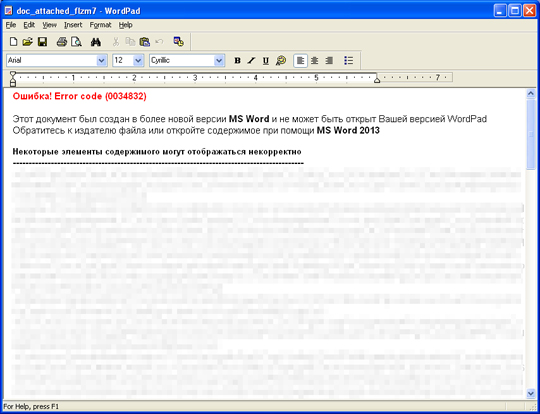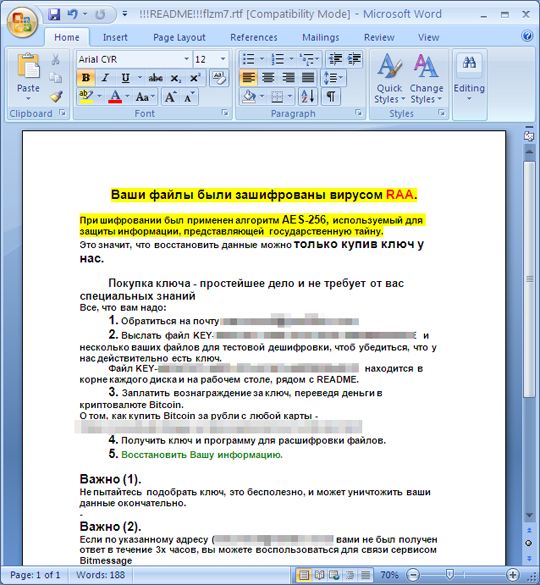RANSOM_RAA.B
Windows


Threat Type: Trojan
Destructiveness: No
Encrypted: Yes
In the wild: Yes
OVERVIEW
This Trojan arrives on a system as a file dropped by other malware or as a file downloaded unknowingly by users when visiting malicious sites.
It gathers information and reports it to its servers.
TECHNICAL DETAILS
Arrival Details
This Trojan arrives on a system as a file dropped by other malware or as a file downloaded unknowingly by users when visiting malicious sites.
Installation
This Trojan drops a copy of itself in the following folders using different file names:
- %My Documents%\{random 5 alphanumeric characters}.js
- (Note: %My Documents% is usually C:\\Documents and Settings\\{user name}\\My Documents on Windows 2000, XP, and Server 2003, or C:\\Users\\{user name}\\Documents on Windows Vista and 7.)
It drops the following files:
- %Desktop%\!!!README!!!{random 5 alphanumeric characters}.rtf-serves as ransom note
- %Desktop%\KEY-{GUID}-contains the key for decryption
- %My Documents%\doc_attached_{random 5 alphanumeric characters}-dummy file
- %My Documents%\{random 5 alphanumeric characters}.dll-non malicious component file(DynamicWrapperX)
- %My Documents%\ii.exe-detected by Trend Micro as TSPY_FAREIT.B
- (Note: %My Documents% is usually C:\Documents and Settings\{user name}\My Documents on Windows 2000, XP, and Server 2003, or C:\Users\{user name}\Documents on Windows Vista and 7.)
(Note: %Desktop% is the desktop folder, where it usually is C:\Documents and Settings\{user name}\Desktop in Windows 2000, Windows Server 2003, and Windows XP (32- and 64-bit); C:\Users\{user name}\Desktop in Windows Vista (32- and 64-bit), Windows 7 (32- and 64-bit), Windows 8 (32- and 64-bit), Windows 8.1 (32- and 64-bit), Windows Server 2008, and Windows Server 2012.)
It adds the following processes:
- %System%\regsvr32.exe /i /s "%My Documents%\{random 5 alphanumeric characters}.dll"
- wordpad.exe "%My Documents%\doc_attached_{random 5 alphanumeric characters}"
- wordpad.exe "%Desktop%\!!!README!!!{random 5 alphanumeric characters}.rtf"
- %My Documents%\ii.exe
- (Note: %My Documents% is usually C:\Documents and Settings\{user name}\My Documents on Windows 2000, XP, and Server 2003, or C:\Users\{user name}\Documents on Windows Vista and 7.)
(Note: %Desktop% is the desktop folder, where it usually is C:\Documents and Settings\{user name}\Desktop in Windows 2000, Windows Server 2003, and Windows XP (32- and 64-bit); C:\Users\{user name}\Desktop in Windows Vista (32- and 64-bit), Windows 7 (32- and 64-bit), Windows 8 (32- and 64-bit), Windows 8.1 (32- and 64-bit), Windows Server 2008, and Windows Server 2012.)
Autostart Technique
This Trojan adds the following registry entries to enable its automatic execution at every system startup:
HKEY_CURRENT_USER\Software\Microsoft\
Windows\CurrentVersion\Run
"" = "%My Documents%\{random 5 alphanumeric characters}.js argument"
Other System Modifications
This Trojan adds the following registry keys:
HKEY_CURRENT_USER\kkoq\Ghsgd
HKEY_CURRENT_USER\kkoq\kkoq-fnl
It adds the following registry entries:
HKEY_CURRENT_USER\kkoq\Ghsgd
"" = {GUID}
HKEY_CURRENT_USER\kkoq\kkoq-fnl
"" = "beenFinished"
It deletes the following registry keys:
HKEY_LOCAL_MACHINE\SYSTEM\ControlSet001\
Services\VSS
Other Details
This Trojan encrypts files with the following extensions:
- .doc
- .xls
- .rtf
- .dbf
- .jpg
- .dwg
- .cdr
- .psd
- .cd
- .mdb
- .png
- .lcd
- .zip
- .rar
It renames encrypted files using the following names:
- {filename of encrypted file}.{extension of encrypted file}.locked
It does the following:
- It avoids encrypting the following folders:
- RECYCLER
- Program Files
- Program Files (x86)
- Windows
- Recycle.Bin
- RECYCLE.BIN
- Recycler
- TEMP
- APPDATA
- AppData
- Temp
- ProgramData
- Microsoft
It gathers the following information and reports it to its servers:
- http://bit.ly/{BLOCKED}MD
NOTES:
This ransomware opens the dropped document file containing a fake error message in Russian language stating that it requires a newer Word version to open the said document:

After its encryption routine, it opens the dropped ransom note:

SOLUTION
Step 1
Before doing any scans, Windows XP, Windows Vista, and Windows 7 users must disable System Restore to allow full scanning of their computers.
Step 2
Note that not all files, folders, and registry keys and entries are installed on your computer during this malware's/spyware's/grayware's execution. This may be due to incomplete installation or other operating system conditions. If you do not find the same files/folders/registry information, please proceed to the next step.
Step 3
Delete this registry key
Important: Editing the Windows Registry incorrectly can lead to irreversible system malfunction. Please do this step only if you know how or you can ask assistance from your system administrator. Else, check this Microsoft article first before modifying your computer's registry.
- In HKEY_CURRENT_USER
- kkoq
- kkoq
Step 4
Delete this registry value
Important: Editing the Windows Registry incorrectly can lead to irreversible system malfunction. Please do this step only if you know how or you can ask assistance from your system administrator. Else, check this Microsoft article first before modifying your computer's registry.
- In HKEY_CURRENT_USER\Software\Microsoft\Windows\CurrentVersion\Run
- = "%My Documents%\{random 5 alphanumeric characters}.js argument"
- = "%My Documents%\{random 5 alphanumeric characters}.js argument"
Step 5
Search and delete this file
- %Desktop%\!!!README!!!{random 5 alphanumeric characters}.rtf
- %Desktop%\KEY-{GUID}
- %My Documents%\doc_attached_{random 5 alphanumeric characters}
- %My Documents%\{random 5 alphanumeric characters}.dll
- %My Documents%\ii.exe
Step 6
Scan your computer with your Trend Micro product to delete files detected as RANSOM_RAA.B. If the detected files have already been cleaned, deleted, or quarantined by your Trend Micro product, no further step is required. You may opt to simply delete the quarantined files. Please check this Knowledge Base page for more information.
Did this description help? Tell us how we did.


